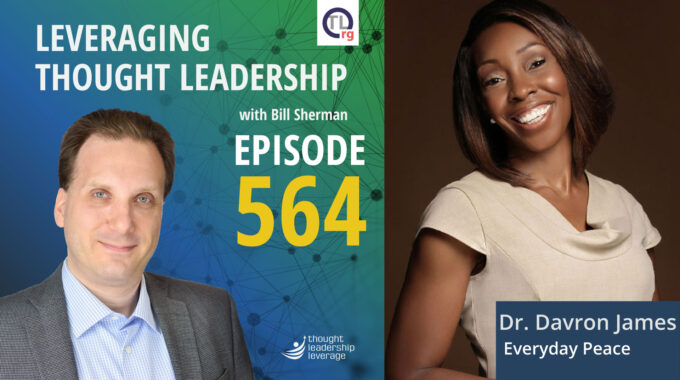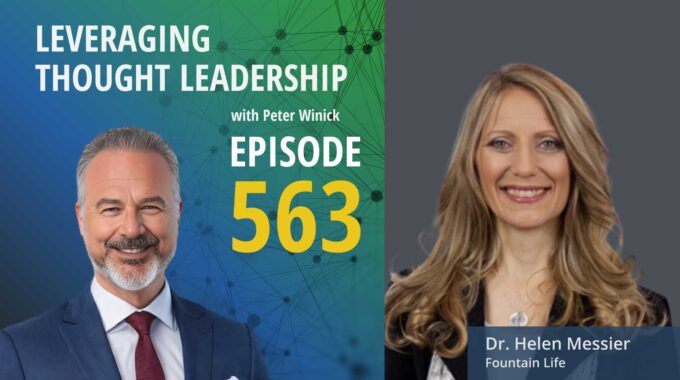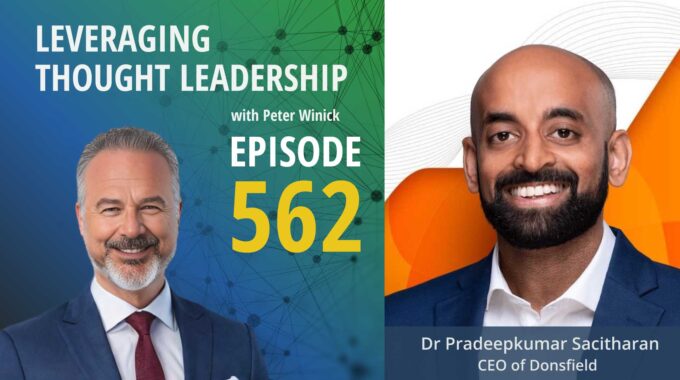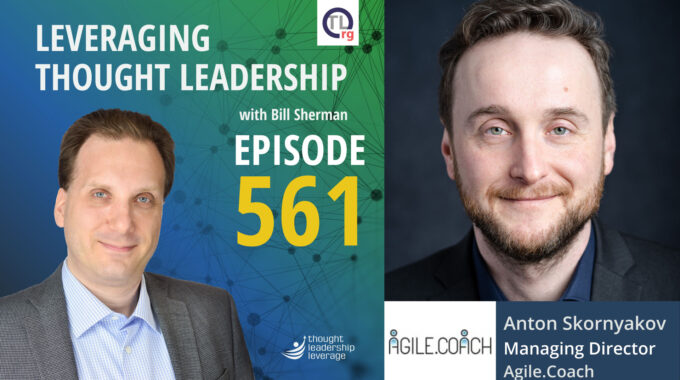Embracing Self-Awareness for Personal Growth and Peace A conversation with Dr. Davron James about her…
Culture as a Strategic Tool | Clint Tripodi
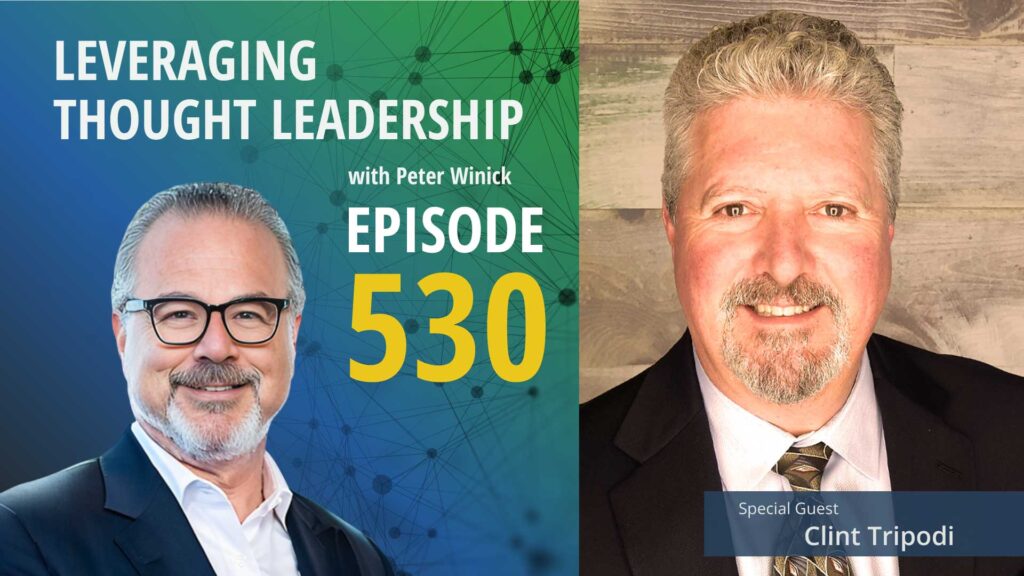
How poor leadership can impact insurance and your bottom line.
An interview with Clint Tripodi about differentiating insurance through thought leadership.
Could poor leadership have a direct impact on workers’ insurance claims?
Today, we go outside the box by discussing insurance with Clint Tripodi. Clint is a National Practice Leader for The Liberty Company where they are changing the way business leaders look at and think about insurance – through the use of thought leadership.
While insurance is often thought of as “mundane,” Clint shares what his company found when they tracked leadership’s impact on workplace culture, and why they are looking to find the root issues, in order to mitigate risks downstream.
Through data analytics, Clint is able to see where claims have an impact, and then go directly to the root of the problem, which is often a lack of leadership. Clint uses data analytics to show the way poor leadership has an effect on workers’ compensation claims as well as employee retention, and ultimately, ROI.
Clint helps us understand how the culture of wellness at Liberty is being spread to their clients through thought leadership that sets them apart from and above the competition!
Three Key Takeaways:
- Culture is a strategic tool and insurance can help you drive that strategy.
- When working in a highly commoditized market you have to position yourself as a business partner, not just a solution.
- Data analytics can help to identify problems so that you can go upstream and fix them at the source.
If you need a strategy to bring your thought leadership to market, Thought Leadership Leverage can assist you! Contact us for more information. In addition, we can help you implement marketing, research, and sales. Let us help you so you can devote yourself to what you do best.

Transcript
Peter Winick And welcome, welcome, welcome. This is Peter Winick. I’m the founder and CEO at Thought Leadership Leverage and you’re joining us on the podcast today, which is leveraging thought leadership. Today. My guest is Clint Tripodi and he has an interesting career. We’re gonna have a cool conversation today. He’s a very well seasoned human resource executive. He’s got an MBA in human resources. He’s more than a consultant. He’s authored over 25 leadership development programs and he is a senior vice president of National Human Capital Management Practice at Liberty Insurance Brokers. So welcome, Clint. How are you?
Clint Tripodi Really good, Peter, thanks for your time today. Looking forward to this conversation.
Peter Winick Great. So here’s where I where I want to start. So insurance, with all due respect, like the ultimate in commodity, the ultimate in boring but a huge business, right? So one of the challenges for anybody in that space is, you know, how do I stand out from competition? How do I engage clients in a market that’s gone largely online, etc.? And, you know, the way that you and Liberty have largely answered that is vis a vis thought leadership. Right? So do you want to talk about that? Because I love the approach.
Clint Tripodi Yeah. Yeah, you’re right. You know, most people work out shirts of the day. They’re at best a necessary evil, right? And then a lot try to connect it to risk mitigation, which is spark. But at the Liberty Company insurance brokers, what we’re trying to do is shift the paradigm that insurance actually impacts workplace culture. And by doing that upstream intervention, you get actually great downstream risks. And I think this is really thought provoking for a lot of insurance buyers because I’ve been on both sides of the table up on PMC for large companies. Sure, we’re on the broker side as well, so it’s just a different way of looking at.
Peter Winick Got it. So how? Have you at Liberty’s. You’ve got the methodologies, the thought leadership, etc. and then there’s a pieces of it that you, let’s say, give that away to prospects and clients to differentiate yourself, attract them into conversations. But then there’s a part of that that has evolved into a consulting business inside of an insurance brokerage, which I love that as well. So unpack that a little bit.
Clint Tripodi Yeah, okay. So this is really cool. So most insurance companies and brokers, they view insurance as a transactional commodity. Yeah. Once when they see that in your attempts to review and then you have an increase in claims, right. And so the broker goes out, changes markets or Right. The player gets all upset, some buyers the broker and try to find some of the better with the better solution. Well we don’t have a live right we see where the claims have the impact and then we go upstream to identify the root cause of the problem. And with that we provide solutions. So someone with my type of backdrop can go in and say, Hey, let’s first got no closed. You guys have a culture problem. The culture problem is a lack of leadership. Now, the players don’t want to hear this, right. But if you think about it, if your leadership culture is draconian, employers are not committed to the organization. So if there’s a workforce injury, hey, man, I’m the first one out the worker’s comp claim and I’m for stretching out as long as I can. So reporters constantly complaining about, let’s say I’m just using worker’s comp as an example of bogus worker’s comp issues, right? Well, why are they focused? Let’s go back upstream and take a look at to what extent have you put in the right safety protocols, To what extent have you develop your leaders? I have a conversation.
Peter Winick Okay. So that’s a stay there a minute, though. So I’ve bought insurance for 30 years and never once has a commercial insurance broker. Talk about the impact of my leadership abilities or lack thereof, or the organization’s culture and its impact on the business, but B directly its impact on potential insurance claims. So I would imagine if I was in the market for insurance and I do the typical well, bring me three brokers and blah, blah, blah, blah blah, that in and of itself is going to get me to scratch my head and go, There’s something different about the way these folks think, right? It’s not just about praise and it’s not just about coverage. And so they really want to understand how I operate and what I’m struggling with because nobody wants to buy insurance. Nobody wakes up and said, I’m so happy today I get to buy workers comp, right? Like nobody. That doesn’t happen.
Clint Tripodi Yeah, I have an incident recently. It was pretty interesting that CEO of a very large company was complaining because he has an increase in what’s called EPL eclipse. Right. Play liability because they’ve had a couple of wrongful termination cases filed against them. So I started talking to him about that. Why are they call firing these claims? And then I asked, and to what extent do you have a formalized leadership development program? Because I’ve never done that before. I just figured leaders restructure. Right? So let’s again go upstream. Let’s start implement some programs to mitigate downstream risk, right? Yep. So it’s still existing for 100 men hacking away at the branches of the disease tree. Only one was stopped. Inspect the route. That’s what the revenue charts brokerage company does. We inspect the root causes of the risks and then we provide solutions in-house. Right. To get it back on track.
Peter Winick So speak for a little bit about. How the thought leadership that you’ve got maps out across the sales cycle from the marketing side to the qualification side to are there tools and such that the agents have to use at their disposal during conversations like where would you, you know, if you had to just sort of map out against the touch points in the sales process?
Clint Tripodi Yeah, well, first of all, it starts with the producer sales education to really understand the prospects business, right? The business versus the insurance solution because you have to position yourself as a business partner, not insured solution provider. So it’s education and understand the link between culture and insurance. That’s number one. Number two, they’ve got to be able to identify root cause problems. And number three, they got to be able to match a solution with subject matter expertise at our company about specific specialty practices, whether it’s safety, human resources, human capital management that can go in at the solution level. Now, that comes with that.
Peter Winick Let me let me just ask you this. So that level of capabilities, development, the education at the broker level, at the agent level is on top of not in place of the table stakes of obviously they need to know insurance and how it works and what’s appropriate and all that sort of stuff. So there’s an extra educational, I want to call it a burden, but there’s a there’s a little bit more to do in order to differentiate. It doesn’t come easy.
Clint Tripodi Yeah, absolutely. And I think the driving force of our firm is we want to differentiate ourselves from all the other insurance solution providers. We want to differentiate ourselves to be viewed as a trusted business partner. Trust. A business partner means you understand the business and you provide solutions for them to optimize your business through the insurance offerings. Okay. So it’s one thing to get license, it’s another thing to sell insurance. It’s a whole nother area to really understand the client’s business and map those solutions together. Right. And everything required to the client’s bottom line. Yes. The piece.
Peter Winick If you’re enjoying this episode of Leveraging Thought Leadership, please make sure to subscribe. If you’d like to help spread the word about our podcast, please leave a five-star review at ratethispodcast.com/ltl and share it with your friends. We’re available on Apple Podcasts and on all major listening apps as well as that thought leadership leverage dot com forward slash podcast.
Peter Winick So speak for a moment about sort of the formats and the modality that that thought leadership could live. So for example, we’re on a podcast today. This is one place where the ideas, the models, the methods, the frameworks that you have and you use for the business. We’re having a conversation. This is a use of thought leadership. Where else and what are the formats? Are you comfortable or. And when I say you, I mean organizationally, are you creating and deploying thought leadership?
Clint Tripodi Oh, I think we’re deployed it in the healthcare industry, right. I think we’re making major inroads. Worker’s compensation as well. The cannabis industry has its own unique set of challenges.
Peter Winick And I’m talking about the formats though, meaning written word, video, research reports. I’m talking about where it lives.
Clint Tripodi Yeah, we’re rare live white papers. We routinely produce white papers. We routinely produce blogs, we do speaking engagements, we do podcasts like we’re doing here, right? We get in front of different insurance associations to get the word out, because more to get the word out, the more it drives prospects of delivery company because it is a differentiator. So we’re using a multifaceted approach because very few insurance companies are talking along these lines, right? When we start talking about these slides also, they understand that. So culture is a strategic tool and insurance can help you drive that strategy to reduce risks and be more productive. Tell me more.
Peter Winick Client So what I love about this is that there are, I don’t know, tens of thousands, hundreds of thousands of folks that are licensed to sell insurance. I would argue there’s less than 1% of them that have made the investments that you all have made and differentiated yourself through thought leadership. So their work on the sales side of this really, really, really hard. And, you know, by definition, when you put yourself in a position to be commoditized, the only thing that really matters is price, Right? Right. When you have a commodity, buy, when you have a strategic business partner, and you sort of hook them, if you will, through thought leadership, that’s different. I want to touch on what you mentioned in terms of all the you know, you’re doing everything from white papers to speaking at conferences and publishing things. And podcasts and such. What are the metrics that you look at to say, Aha, this is working? So ultimately you know that when I came in and I met you said I met you at this conference or I heard you had that blog, awesome. You could track that. But part of the difficulty from an organizational perspective with thought leadership is it’s not so easy to track everything to the 11th decimal like we like to with or like to think we can with many other things. So can you can you speak to that for a moment?
Clint Tripodi So that’s a good point because we’re talking here about culture, right? Culture is a feeling. If you take a look at the root of culture, it means care. How do you measure that? Right? What are the metrics from an assurance perspective? We have data analytics. So we take a new client that has an extremely high modification rate on their work. Your score. Okay, we isolate where the problem is. We go and we intervene. And then a year later we take a look at the claims data as a base point of measurement to make that happen. Employee benefits. Employee benefits. At the end of the day, what do they drive? Employee attraction and retention. To what extent are you to curtail and change your attrition rate? All of that equates to the bottom life on the AB side as well as worker’s comp side. So there are ways to put in metrics to track the efficacy of the work that we’re doing.
Peter Winick Got it. And where how would I put it? Well, I’ll take it back to culture. There are times where culturally I would say you’re actually taking a risk from a marketing standpoint only by definition of it’s, you know, it’s not a bet the house rich risk, but it’s not traditional. It’s not typical. How did you go about sort of selling this internally? You didn’t just come to work one day and say, I’m going to do all this stuff, you know, trust me. How did this come to be? Because I think a lot of people sort of get it, but they don’t know how to sort of sell it internally to their boss, to the powers that be to get some budget allocated. How did you navigate those waters?
Clint Tripodi Yeah, well, I was really fortunate in our chairman for the founder is Bill Johnson as he is very values driven individual. He really stands behind the culture of the company. We have eight values that are statements that we stand behind. He was looking for ways to connect the Liberty Insurance culture with the clients culture, which is really based around wellness. Right? And so my methodology did come in at a business angle, supplemented with insurance. From his perspective, it’s like, number one is we’re propagating the philosophy and number two, clip you’re baby the superstar to take the average lifespan of insurance clients from 3 to 5 years to 7 to 10 years because you’re developing the business relationship on top of the insurance relationship. And then I also will talk a little bit here about what you said earlier, a risk manager or a broker, whether they’re looking at data analytics, they need to possess three mindsets, right? Number one, curiosity. What is going on with our client that’s driving costs? Number two, make the correct choices. And number three, puter the perfect right to search for me to look at one of our clients to say The root cause of your claims increases is a lack of leadership. Wow. Right. You put yourself out. Yeah, but. But I have to have that conversation because as a consultant, I need to be honest about it. I can’t just ignore them because it’s. It’s not that which is happy.
Peter Winick But it’s not the answer they’re expecting. It also takes courage as a consultant. It’s easy as a consultant to say the problem is over there. Those people aren’t doing what they need to do. And therefore. But in essence, what you’re doing is holding up a mirror and saying, I found the root cause of the problem. Here’s the mirror. And they go, Oh, geez, like, like, you know.
Clint Tripodi And we have a solution because you can.
Peter Winick More importantly, right.
Clint Tripodi You can’t pull back that to say, you know, the problem is the leader at the top, the organization, sets the tone of organization. The CEO is draconian. Right. Right. You’re not going to remove the CEO, but you got to be like.
Peter Winick Right. Right. Thanks for the calls that way. Appreciate it.
Clint Tripodi You have to have a solution that says we’re going to come in, review the strategy, or do some work to shift to a more people centric culture of overdue leadership, development, training, coaching first, all blocking and tackling it. And the healing said the word disputer. If that club recognizes that they have a leadership problem and they take the steps right to improve it, then the measurement is downstream. Risk mitigation. Esplin Through insurance analytics, we have that that you just got to take it back. You got to take it all the way back straight.
Peter Winick Great. Well, I appreciate your time, Clint. This has been awesome. A little bit different than where we usually go a little more into the weeds on insurance. But but the takeaway here for the listeners is really thinking about where your business could benefit from the development, from the deployment, from the curation, from the investments in thought leadership to attract customers, to fight the commoditization that’s happening in every business or service, whether it’s product service, etc.. So. Appreciate your time and your insights today, Clint.
Clint Tripodi That sounds good. Peter, thank you very much.
Peter Winick To learn more about Thought Leadership Leverage, please visit our web site at ThoughtLeadershipLeverage.com to reach me directly. Feel free to email me at Peter at thoughtleadershipleverage.com and please subscribe to Leveraging Thought Leadership on iTunes or your favorite podcast app to get your weekly episode automatically.

